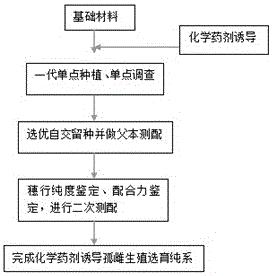Method for obtaining pure line through inducing parthenogenesis of Zea mays by chemical agent
A technology of chemical agents and parthenogenesis, which is applied in the direction of botany equipment and methods, application, plant gene improvement, etc., can solve the problems of foreign pollen pollution, difficult selection of seeds, cumbersome chromosomes, etc. The effect of increasing the number and improving the induction efficiency
- Summary
- Abstract
- Description
- Claims
- Application Information
AI Technical Summary
Problems solved by technology
Method used
Image
Examples
Embodiment 1
[0033] The concrete steps of a kind of method that chemical agent induces maize parthenogenesis to obtain pure line of the present invention are as follows:
[0034] 1. Preparation of chemical agents: Prepare a mixed solution of 2% DMSO and 40mg / L MH as the induction agent, add absorbent cotton balls with a diameter of 2.0cm to the induction agent and soak for 26 hours in advance;
[0035] 2. Selection of processing materials: corn hybrid "Demeiya 2";
[0036] 3. Induction treatment: Before the filaments are drawn out, when the tassels are seen, all the tassels of the plants to be treated are pulled out, and the spikes are strictly bagged. After the filaments are spit out for 1-3 days, before the dew disperses in the morning on the day of treatment, disinfect the scissors with alcohol with a volume concentration of 72%, and cut out a notch at the threading place; use tweezers to take out the absorbent cotton ball dipped in the inducer and place it in the notch. Do not take ou...
Embodiment 2
[0041] The concrete steps of a kind of method that chemical agent induces maize parthenogenesis to obtain pure line of the present invention are as follows:
[0042] 1. Preparation of chemical agents: Prepare a mixed solution of 2% DMSO and 40mg / L MH as the induction agent, add absorbent cotton balls with a diameter of 1.5cm to the induction agent and soak for 28 hours in advance;
[0043] 2. Selection of processing materials: corn hybrid "Waiyin 1124";
[0044] 3. Induction treatment: Before the filaments are drawn out, when the tassels are seen, all the tassels of the plants to be treated are pulled out, and the spikes are strictly bagged. After the filaments are spit out for 1-3 days, before the dew disperses in the morning on the day of treatment, disinfect the scissors with alcohol with a volume concentration of 75%, and cut out a notch at the threading place; use tweezers to take out the absorbent cotton ball dipped in the inducer and place it in the notch. Do not take ...
Embodiment 3
[0049] The concrete steps of a kind of method that chemical agent induces maize parthenogenesis to obtain pure line of the present invention are as follows:
[0050] 1. Preparation of chemical agents: Prepare a mixed solution of 2% DMSO and 40mg / L MH as the induction agent, add a cotton ball with a diameter of 1.5cm to the induction agent and soak for 26 hours in advance;
[0051] 2. Select treatment materials: mid-to-late maturing corn hybrid "Xianyu 335";
[0052] 3. Induction treatment: Before the filaments are drawn out, when the tassels are seen, all the tassels of the plants to be treated are pulled out, and the spikes are strictly bagged. After the filaments are spit out for 1-3 days, before the dew disperses in the morning on the day of treatment, disinfect the scissors with alcohol with a volume concentration of 70%, and cut out a notch at the threading place; use tweezers to take out the absorbent cotton ball dipped in the inducer and place it in the notch. Do not t...
PUM
| Property | Measurement | Unit |
|---|---|---|
| Diameter | aaaaa | aaaaa |
| Diameter | aaaaa | aaaaa |
| Diameter | aaaaa | aaaaa |
Abstract
Description
Claims
Application Information
 Login to View More
Login to View More - R&D
- Intellectual Property
- Life Sciences
- Materials
- Tech Scout
- Unparalleled Data Quality
- Higher Quality Content
- 60% Fewer Hallucinations
Browse by: Latest US Patents, China's latest patents, Technical Efficacy Thesaurus, Application Domain, Technology Topic, Popular Technical Reports.
© 2025 PatSnap. All rights reserved.Legal|Privacy policy|Modern Slavery Act Transparency Statement|Sitemap|About US| Contact US: help@patsnap.com

